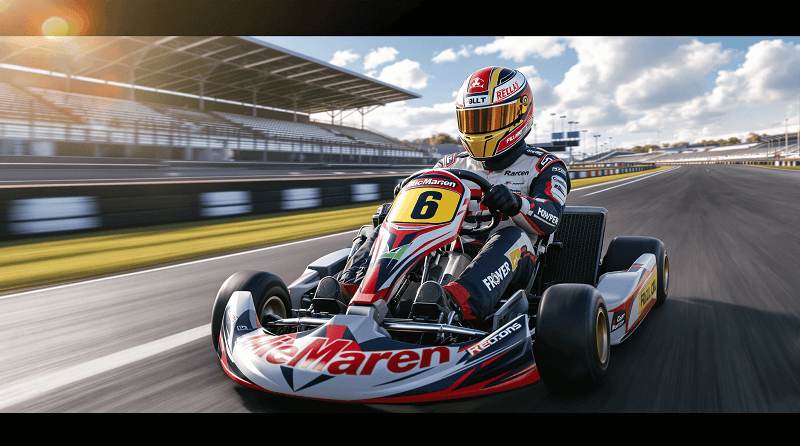When I first got into go-karting, one of the most confusing maintenance questions was figuring out the right go-kart oil change frequency. Change it too often, and you’re wasting money. Wait too long, and you risk damaging your engine. Getting this right is crucial for both performance and longevity of your kart.
After years of racing and maintaining go-karts, I’ve learned exactly what works best for different engines and racing conditions. In this guide, I’ll share everything you need to know about keeping your go-kart’s oil in optimal condition.
Why Oil Changes Matter for Your Go-Kart
Oil is literally the lifeblood of your go-kart’s engine. It serves multiple critical functions:
- Lubricates moving parts to reduce friction and wear
- Helps cool the engine by transferring heat
- Cleans internal components by carrying away debris
- Seals gaps between piston rings and cylinder walls
- Protects metal surfaces from corrosion
Over time, oil breaks down and becomes contaminated with dirt, metal particles, and combustion byproducts. When this happens, it can’t perform these vital functions effectively, putting your engine at risk.
The Standard Go-Kart Oil Change Frequency
The general rule of thumb for recreational go-karts is to change the oil every 10-20 hours of operation. However, this is just a starting point. For racing karts that are pushed to their limits, you might need to change oil as frequently as every 3-5 hours of track time.
Go-Kart Oil Change Calculator
Go-Kart Oil Change Calculator
Your Oil Change Recommendation
Factors That Affect Your Go-Kart’s Oil Change Schedule
Several variables influence how often you should change your go-kart’s oil:
1. Engine Type
Two-stroke and four-stroke engines have different oil requirements:
- Two-stroke engines: These typically mix oil with fuel, so there’s no traditional “oil change.” Instead, you’ll need to maintain the correct oil-to-fuel ratio. The oil is consumed during operation.
- Four-stroke engines: These have a separate oil reservoir and require regular oil changes similar to a car, but more frequently due to the high-stress operation.
If you’re curious about the differences between these engine types, check out my detailed comparison of two-stroke vs. four-stroke engines to understand which might be better for your needs.
2. Racing vs. Recreational Use
How you use your go-kart dramatically impacts oil change frequency:
- Racing use: When pushing your kart to its limits, oil degrades faster due to higher RPMs, temperatures, and stress. Competitive racers often change oil before each race day.
- Recreational use: More relaxed driving puts less strain on the engine, allowing for longer intervals between oil changes.
3. Environmental Conditions
The conditions you drive in matter too:
- Dusty or dirty environments: Require more frequent oil changes as contaminants enter the engine
- Extreme temperatures: Both very hot and very cold conditions can accelerate oil breakdown
- Wet conditions: Racing in the rain can introduce moisture into the engine, potentially contaminating the oil
For tips on how to handle wet conditions, see my guide on go-karting in wet weather.
4. Oil Quality
Not all oils are created equal:
- Conventional oils: Generally require more frequent changes
- Synthetic oils: Typically last longer and provide better protection, especially in extreme conditions
- Racing-specific oils: Formulated for high-performance applications but may need more frequent changes
Oil Change Schedule By Kart Type
Different go-karts have different maintenance needs. Here’s a breakdown of recommended oil change intervals:
| KART TYPE | NORMAL USE | HEAVY/RACING USE | OIL TYPE RECOMMENDATION |
|---|---|---|---|
| Rental Karts | Every 20-30 hours | N/A | As specified by manufacturer |
| Recreational Karts | Every 10-20 hours | Every 5-10 hours | 10W-40 or as specified |
| Racing Karts HIGH MAINTENANCE | Every 5-10 hours | Every 2-5 hours | Synthetic racing oil |
| Shifter Karts HIGH MAINTENANCE | Every 3-5 hours | After each race day | High-performance synthetic |
| Kid’s Karts | Every 15-25 hours | Every 10 hours | As specified by manufacturer |
Warning Signs You Need an Oil Change
Your go-kart will often tell you when it needs fresh oil. Watch for these signs:
- Dark, dirty oil: Fresh oil is amber; if it’s dark brown or black, it’s time for a change
- Unusual engine noises: Knocking, ticking, or grinding sounds can indicate insufficient lubrication
- Decreased performance: Loss of power or sluggish acceleration
- Burning smell: May indicate overheating due to inadequate oil protection
- Visible smoke: Excessive smoke can signal oil burning or leaking into combustion chambers
- Warning lights: If your kart has an oil pressure warning light and it comes on, stop immediately
How to Check Your Go-Kart’s Oil
Regular oil checks are essential for maintaining your kart. Here’s how to do it properly:
- Ensure the engine is cool or at least hasn’t been run for 10-15 minutes
- Place the kart on level ground
- Locate and remove the dipstick (if equipped)
- Wipe the dipstick clean with a lint-free cloth
- Reinsert the dipstick fully, then remove it again
- Check the oil level against the markings on the dipstick
- Also note the oil’s color and consistency
For more comprehensive maintenance tips, see my complete guide on how to maintain your go-kart for peak performance.
Step-by-Step Go-Kart Oil Change Process
Changing your go-kart’s oil is a straightforward process that takes about 15-30 minutes:
- Warm up the engine: Run it for a few minutes to warm the oil (makes it flow better)
- Turn off the engine and place the kart on a level surface
- Locate the drain plug underneath the engine
- Place an oil catch pan under the drain plug
- Remove the drain plug and allow all oil to drain completely (5-10 minutes)
- Replace the drain plug (consider replacing the washer if needed)
- Remove the oil fill cap on top of the engine
- Add new oil slowly, checking the level with the dipstick
- Replace the oil fill cap securely
- Run the engine briefly to circulate the new oil
- Check for leaks around the drain plug
- Recheck the oil level after the engine has cooled
Pro tip: Keep a maintenance log to track your oil changes. Note the date, hours/mileage, oil type used, and any observations about the old oil or engine performance.
Best Oil Types for Go-Karts
Choosing the right oil is just as important as changing it regularly:
Four-Stroke Kart Engines
- Recreational use: 10W-40 or 10W-30 automotive oil (conventional or synthetic)
- Racing use: Synthetic racing oil with zinc additives (ZDDP) for better protection
- Brands to consider: Motul, Shell Advance, Castrol Power 1, Amsoil
Two-Stroke Kart Engines
- Oil-to-fuel ratio: Typically 16:1 to 32:1 (check your engine manufacturer’s recommendation)
- Oil type: Two-stroke premix oil specifically designed for air-cooled racing engines
- Brands to consider: Motul, Maxima, Bel-Ray, Castrol
Seasonal Considerations for Oil Changes
Your go-kart’s oil needs change with the seasons:
Winter Storage
Before storing your kart for the winter, always change the oil to remove contaminants that could cause corrosion during storage. For more winter storage tips, read my guide on how to winterize a go-kart.
Spring Startup
Always change the oil before your first spring run, even if you changed it before winter storage. Old oil can absorb moisture during storage.
Summer Racing
In hot weather, consider a slightly higher viscosity oil or more frequent changes as heat accelerates oil breakdown.
Oil Change Cost Considerations
Maintaining your go-kart’s oil is relatively inexpensive compared to potential engine repairs:
- DIY oil change cost: $15-40 depending on oil type and quantity
- Professional oil change: $40-80 at a kart shop
- Cost of neglect: Engine rebuilds can cost $500-2,000+ depending on damage
When considering the overall expense of go-karting, proper maintenance like regular oil changes should be factored into your budget. For more on the costs of go-karting, see my article on go-kart cost breakdown.
Oil Change Frequency FAQ
Can I extend oil change intervals with synthetic oil?
Yes, synthetic oils typically allow for somewhat longer intervals between changes, but don’t push it too far. Even the best synthetic oils still get contaminated over time.
Should I change oil after break-in period?
Absolutely! The first oil change should come early – typically after 1-2 hours for a new engine – to remove metal particles generated during break-in.
Do rental karts need oil changes?
Yes, but that’s handled by the facility staff. Rental karts typically follow a strict maintenance schedule based on hours of operation.
What happens if I miss an oil change?
Occasional slight delays won’t immediately damage your engine, but consistently neglecting oil changes will lead to increased wear, reduced performance, and potentially catastrophic engine failure.
Should I change oil before or after racing season?
Ideally, both. Change it at the end of the season before storage and again at the beginning of the new season.
The Impact of Racing Style on Oil Life
Your driving style significantly affects how quickly your oil degrades:
- Aggressive driving with high RPMs and hard braking degrades oil faster
- Smoother driving with gradual acceleration and deceleration extends oil life
- Frequent short sessions without allowing the engine to reach operating temperature can contaminate oil with fuel and moisture
For tips on improving your driving technique (which can also extend your oil life), check out my article on go-kart cornering technique.
When to Consider More Frequent Oil Changes
Some situations call for more frequent oil changes regardless of the standard recommendations:
- After driving in extremely dusty or dirty conditions
- Following any water exposure to the engine
- After noticing metal particles or debris in the old oil
- When troubleshooting engine performance issues
- Before important races or events
- After engine repairs or modifications
Final Thoughts on Go-Kart Oil Change Frequency
Regular oil changes are among the most important maintenance tasks for your go-kart. While general guidelines suggest changing oil every 10-20 hours for recreational use or 3-5 hours for racing, your specific schedule should be tailored to your kart, driving style, and conditions.
When in doubt, change your oil more frequently rather than less. The cost of an oil change is minimal compared to the potential expense of engine repairs. Plus, fresh oil ensures your kart performs at its best when you need it most.
Remember to dispose of used oil properly by taking it to an auto parts store or recycling center that accepts used motor oil. Never pour it down drains or onto the ground.
By staying diligent with your go-kart’s oil change schedule, you’ll enjoy better performance, longer engine life, and more reliable operation every time you hit the track.

Goran, an experienced go-kart racer, fuels GoKartLife.com with his passion and expertise. He offers valuable insights and tips for fellow enthusiasts, fostering the growth of the go-kart community. Join Goran at GoKartLife.com and immerse yourself in this exhilarating sport.
Last modified: April 27, 2025



